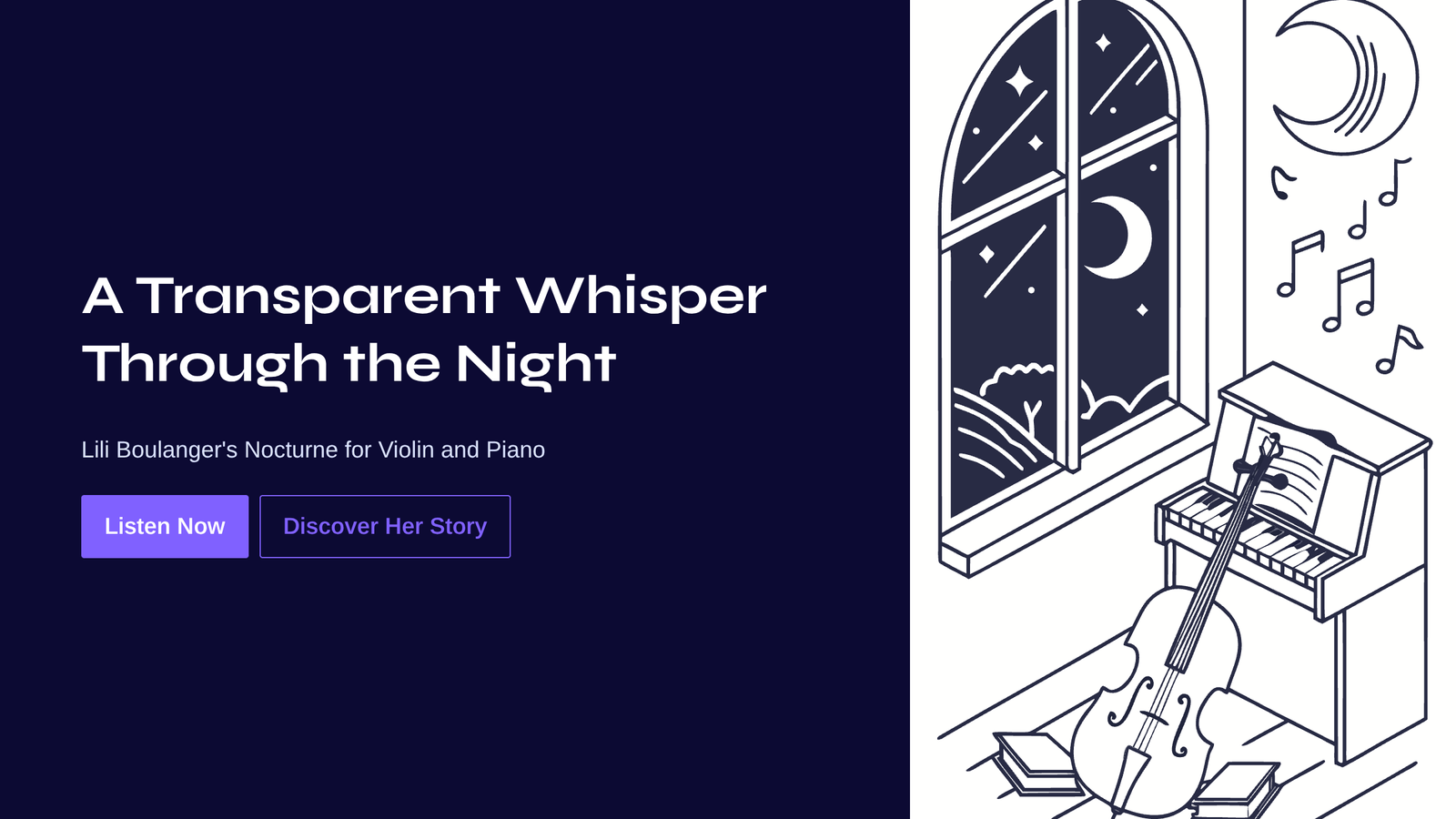Table of Contents
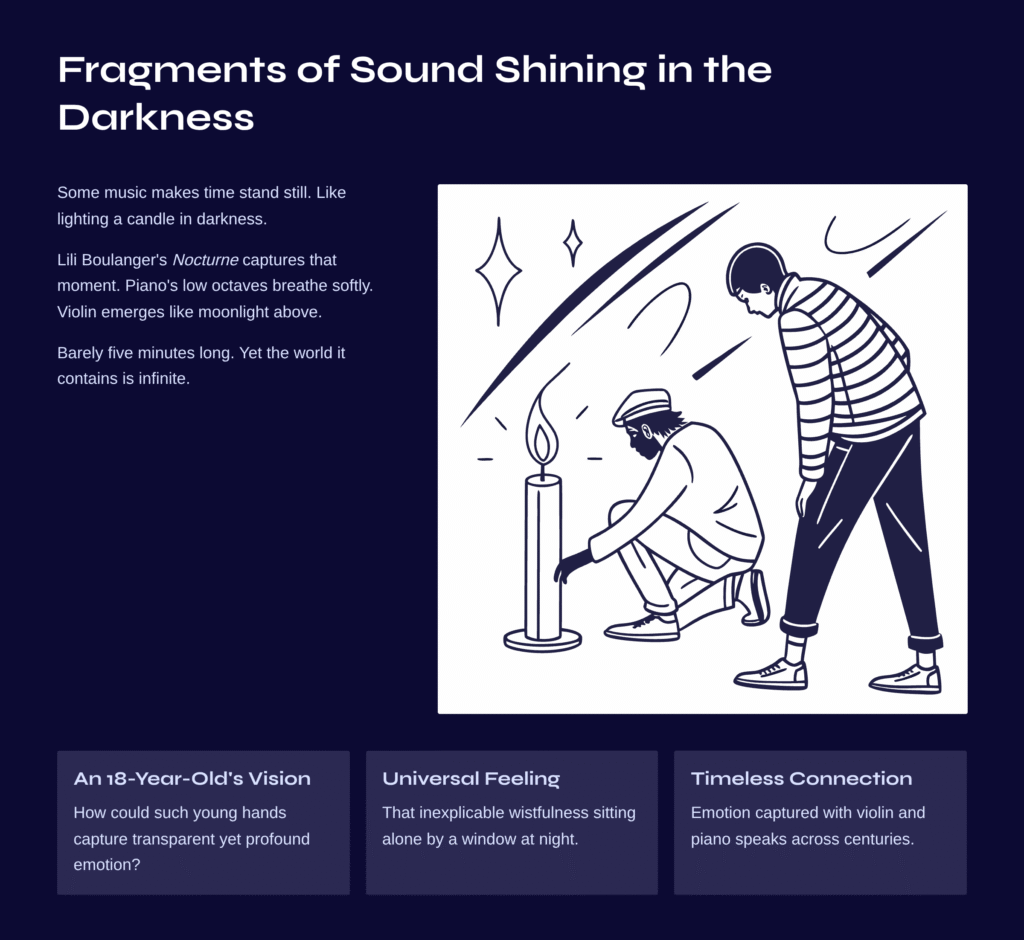
Fragments of Sound Shining in the Darkness
Some music makes time stand still the moment you hear it. Like someone lighting a candle in the darkness, there are melodies that seep gently into silent spaces. When I first heard Lili Boulanger’s Nocturne for Violin and Piano, I had such an experience. The moment when piano’s low octaves lay like a breath, and above them the violin emerges softly like moonlight—it wasn’t simply “music of the night,” but rather like touching with fingertips the intimate folds of emotion that night holds.
Boulanger’s Nocturne is a brief piece, barely five minutes long, yet the world it contains is infinite. How could an 18-year-old composer capture such transparent yet profound emotion in music? Perhaps you’ve felt it too—sitting alone by a window on some night, experiencing an inexplicable wistfulness. That moment’s emotion, Lili Boulanger captured with violin and piano.
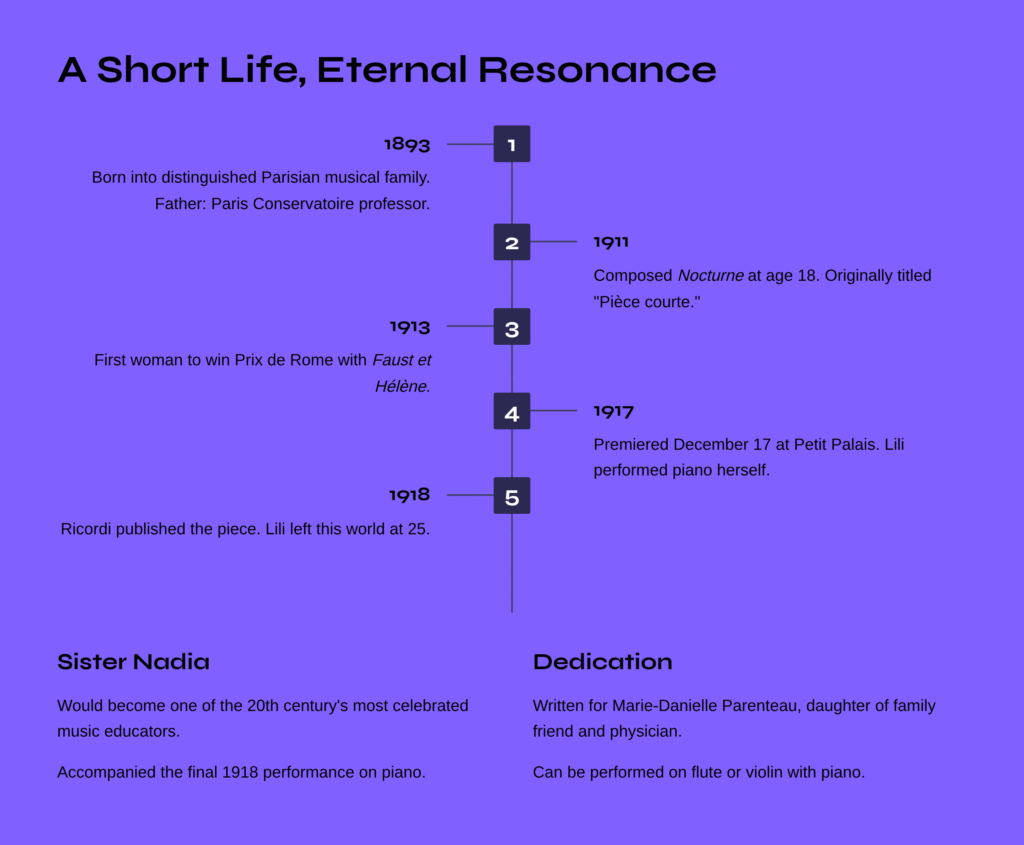
A Short Life, Eternal Resonance – The Composer and the Work’s Birth
Lili Boulanger (1893-1918) was born into a distinguished Parisian musical family. Her father was a professor at the Paris Conservatoire, and her sister Nadia Boulanger would later become one of the 20th century’s most celebrated music educators. But Lili was not blessed with good health from birth. She suffered from pneumonia and left this world at the tender age of 25.
Nevertheless, Lili Boulanger became the first woman to win the prestigious Prix de Rome in 1913 with her cantata Faust et Hélène. This honor proved her genius, but also revealed how much she had to accomplish in such a short time.
Nocturne for Violin and Piano was completed in 1911, when Lili Boulanger was merely 18 years old. Originally titled “Pièce courte” (Short Piece), it was dedicated to Marie-Danielle Parenteau, the daughter of a family friend and physician. Composed to be performed on either flute or violin with piano, the violin version became more widely known.
It was premiered on December 17, 1917, at the Petit Palais in Paris, performed by violinist Émile Mendels with the composer herself at the piano. A year later, when it was performed again with her sister Nadia’s piano accompaniment, people realized how much profound emotion this small work contained. In 1918, the year Lili left this world, Ricordi published the piece. Like her final farewell.
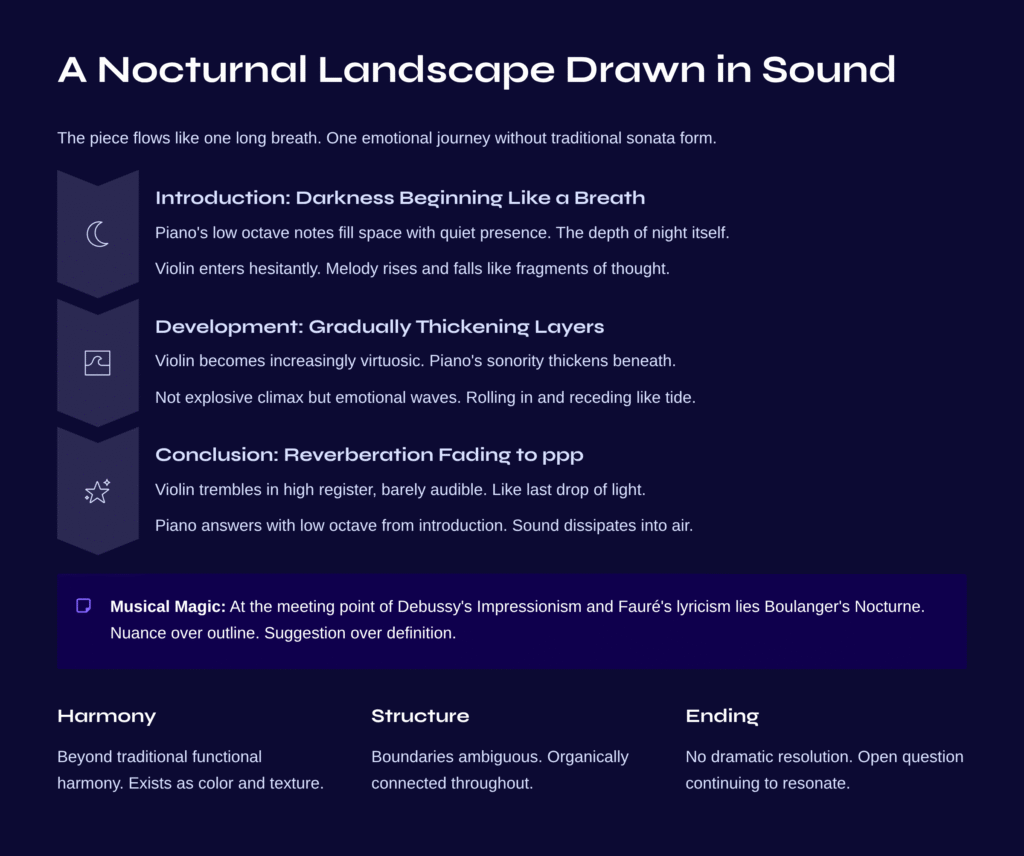
A Nocturnal Landscape Drawn in Sound – Musical Structure and Flow
Lili Boulanger’s Nocturne doesn’t follow traditional sonata form. Instead, it flows like one long breath, one emotional journey. It can be divided roughly into three parts, but the boundaries are ambiguous and organically connected.
Introduction: Darkness Beginning Like a Breath
The piece begins with the piano’s low octave notes. Like someone drawing a deep breath, it fills the space with quiet yet unmistakable presence. This bass is not mere background. It is the depth of night, something latent within the silence.
Then the violin enters. At first hesitantly, cautiously. The melody, rising and falling repeatedly, emerges like fragments of thought. A melody beautiful simply for existing, without any certainty. This thematic melody fully embodies the characteristics of French Impressionist music—nuance over clear outline, suggestion over definition.
The piano moves beneath the violin like rippling water. The harmonies exist beyond traditional functional harmony, as color and texture. At the meeting point of Debussy’s Impressionism and Fauré’s lyricism lies Lili Boulanger’s Nocturne.
Development: Gradually Thickening Layers of Emotion
The introduction’s caution gradually transforms. The violin melody becomes increasingly virtuosic, the piano’s sonority thickens. But this isn’t a linear ascent toward explosive climax. Rather, it’s an emotional wave, rolling in and receding like the tide.
When the violin soars into the high register, it’s not a cry but an earnest plea. Like an attempt to convey in sound something words cannot express. The piano moves ceaselessly beneath, supporting the violin and sometimes responding in dialogue.
The harmony constantly shifts. While avoiding clear tonal centers, it never feels lost. This is the magic of Impressionist music—not losing direction, but existing in an open space where all directions are possible.
Conclusion: Reverberation Fading to ppp
After the development’s emotional surge reaches its peak, the piece suddenly quiets. The violin trembles in a very high register at ppp (very, very soft). It exists like the last drop of light, barely audible.
And the piano answers. With that low octave heard in the introduction. As if returning to where it began. But now that sound is not the same as at first. We have experienced a journey, and something has changed.
There is no dramatic harmonic resolution. No definitive cadence. Instead, the sound dissipates like seeping into air. As if night doesn’t end but continues. This open ending is Lili Boulanger’s question to us—does music end, or does it continue resonating within us?
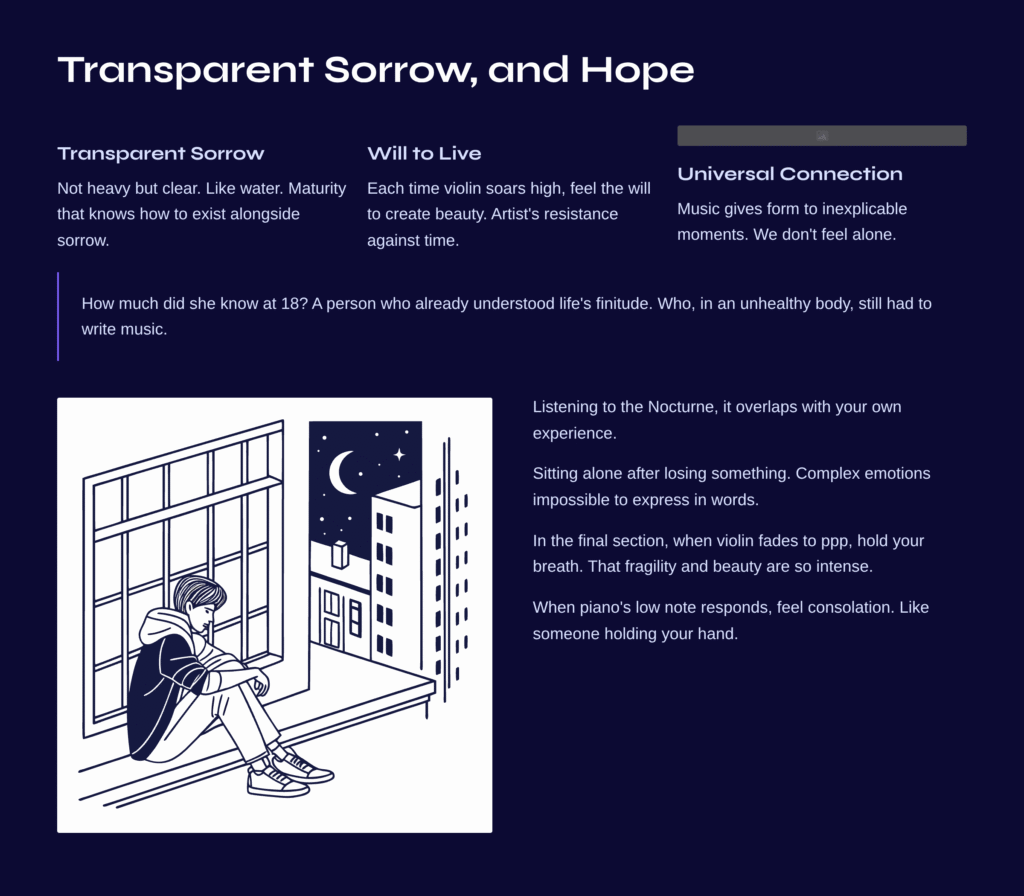
Transparent Sorrow, and Hope – Personal Interpretation and Emotional Journey
Listening to Lili Boulanger’s Nocturne, I often wonder how much she knew. A person who, at 18 years old, already understood life’s finitude. Someone who, in an unhealthy body, still had to write music.
There is sorrow in this piece. But it’s not a heavy sorrow. Rather, it’s transparent. Like clear water. There’s a maturity that knows how to acknowledge sorrow and exist alongside it.
At the same time, there’s hope. Each time the violin soars to high notes, I feel the will to live. Even in a sick body, even knowing a short life, the will to create beauty. Is this the artist’s resistance? Against time and death?
Listening to the Nocturne, there are moments when it overlaps with your own experience. Perhaps you too have sat alone on a night after losing something, gazing out the window? Or been engulfed in complex emotions impossible to express in words? Lili Boulanger’s music gives form to such moments. That’s why we don’t feel alone.
Especially in the final section, when listening to the violin sound fading to ppp, I always hold my breath. The fragility and beauty of that moment are so intense that even breathing seems like it would interfere. And when the piano’s low note responds, I feel a consolation like someone holding my hand.
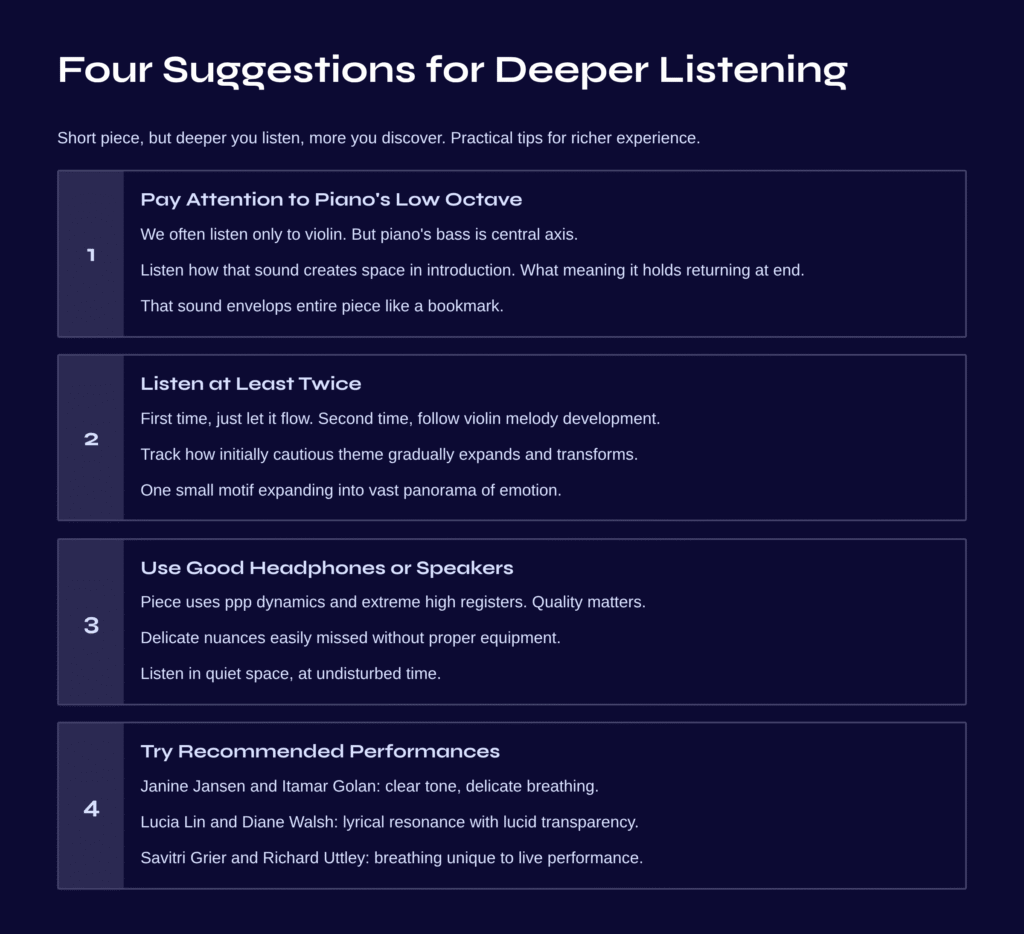
Four Suggestions for Deeper Listening – Tips for Appreciation
Lili Boulanger’s Nocturne is a short piece, but the deeper you listen, the more you discover. To help you experience this music more richly, here are some practical suggestions.
First, pay attention to the piano’s low octave. We often listen only to the violin, the melody instrument, but the piano’s bass is this piece’s central axis. Listen consciously to how that sound creates space in the introduction, and what meaning it holds when it returns at the end. You’ll discover that sound envelops the entire piece like a bookmark.
Second, listen at least twice. The first time, just let it flow; the second time, follow how the violin melody develops. Tracking the process of how the initially cautious theme gradually expands and transforms, you’ll see the composer’s intent more clearly. You’ll be amazed at how one small motif can expand into a vast panorama of emotion.
Third, listen with good headphones or speakers. This piece uses ppp (very soft) dynamics and extreme high registers. Without quality playback equipment, these delicate nuances are easily missed. Especially to properly hear the ending’s tremolo, the moment when the violin plays almost to the point of disappearing, sound quality matters. I recommend listening in a quiet space, at an undisturbed time.
Fourth, for recommended performances, try Janine Jansen and Itamar Golan’s version. It’s an interpretation distinguished by clear tone and delicate breathing. Also, Lucia Lin and Diane Walsh’s performance harmonizes lyrical resonance with lucid transparency beautifully. If you want to feel the breathing unique to live performance, Savitri Grier and Richard Uttley’s YouTube video is also an excellent choice.
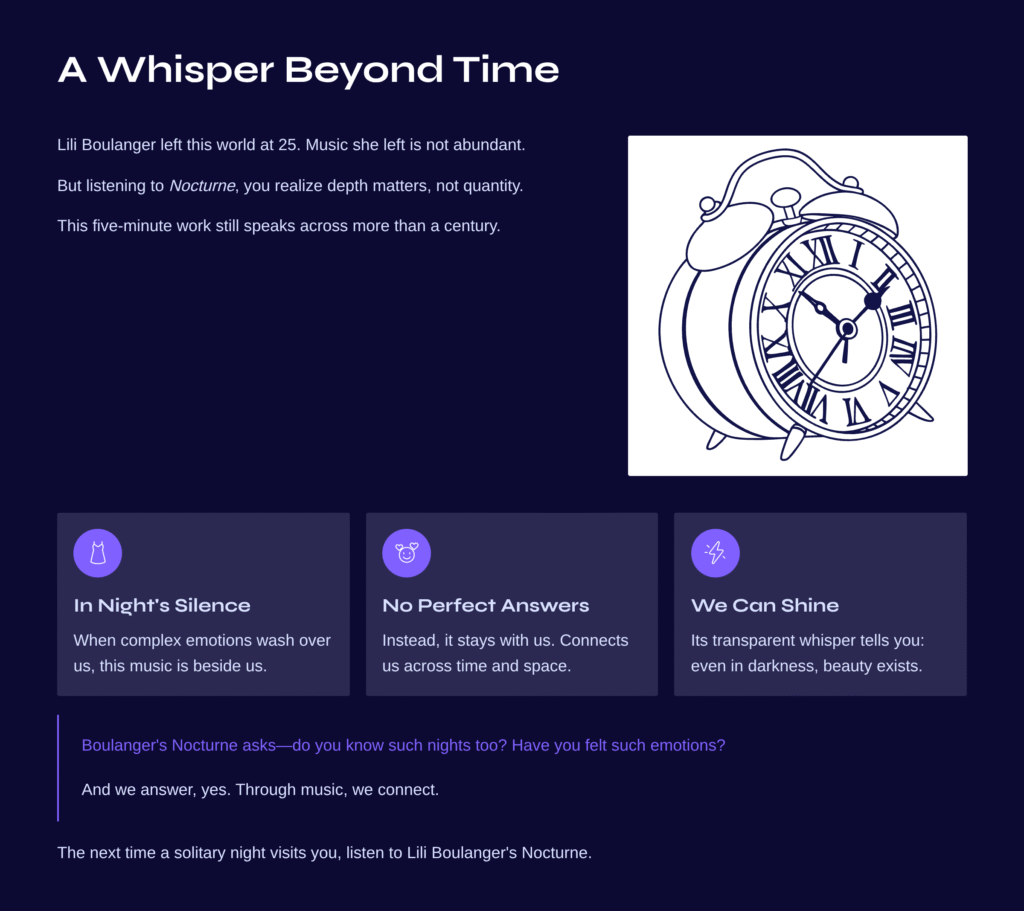
A Whisper Beyond Time
Lili Boulanger left this world at 25. The music she left behind is not abundant. But listening to Nocturne for Violin and Piano, you realize that depth, not quantity, is what matters.
This five-minute work still speaks to us across more than a century. In night’s silence, or when complex emotions wash over us, this music is beside us. It doesn’t give perfect answers. Instead, it stays with us.
Boulanger’s Nocturne asks—do you know such nights too? Have you felt such emotions? And we answer, yes. Through music, across time and space, we connect.
The next time a solitary night visits you, listen to Lili Boulanger’s Nocturne. Its transparent whisper will tell you that even in darkness, we can shine.
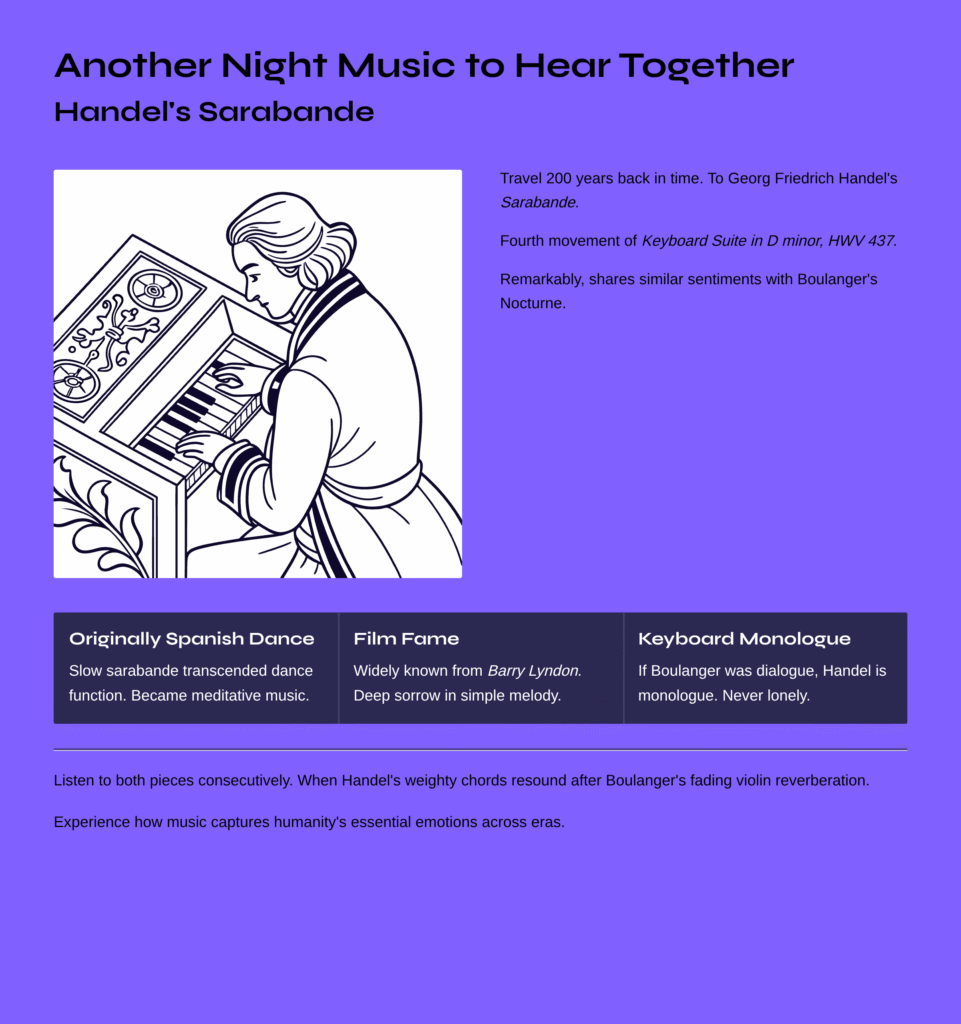
Another Night Music to Hear Together – Handel’s Sarabande
If you’ve experienced Lili Boulanger’s transparent lyricism, why not travel even further back in time? To the Sarabande left by Baroque master Georg Friedrich Handel.
Handel’s Sarabande is the fourth movement of Keyboard Suite in D minor, HWV 437, composed about 200 years before Lili Boulanger’s Nocturne. Yet remarkably, these two works share similar sentiments—intimate and serene, universal sorrow and beauty that transcend time.
The sarabande was originally a slow Spanish dance, but through Handel’s hands it transcended its dance function to become meditative music. This D minor Sarabande in particular became widely known to the public when it was inserted into the film Barry Lyndon. Deep sorrow hidden within simple melody, and the power of rhythm that keeps moving forward while holding that sorrow—this is the piece’s charm.
If Lili Boulanger’s Nocturne was a dialogue between violin and piano, Handel’s Sarabande is a monologue unfolding with keyboard alone. But that monologue is never lonely. Rather, there’s a universality discovered within solitude.
Listen to both pieces consecutively. When Handel’s weighty chords resound after the fading violin reverberation of Boulanger’s ppp—you’ll experience how music captures humanity’s essential emotions across eras. The night is long, and music is with us.
Recommended Recordings
– Janine Jansen & Itamar Golan – Transparent and delicate interpretation
– Lucia Lin & Diane Walsh – Performance with outstanding lyrical resonance
– Savitri Grier & Richard Uttley – Version alive with live performance immediacy
Works to Enjoy Together
– Lili Boulanger Cortège – Nocturne’s sister work, contrast of lightness and elegance
– Georg Friedrich Handel Sarabande (HWV 437) – Timeless meditative beauty
